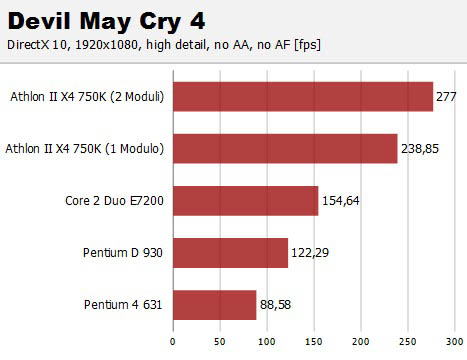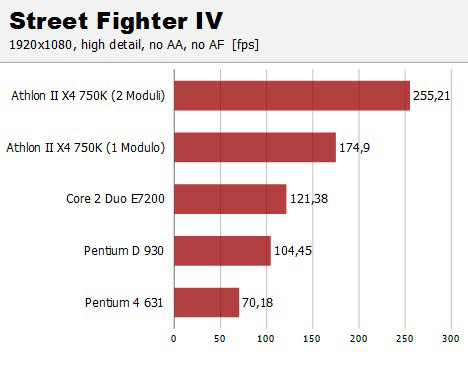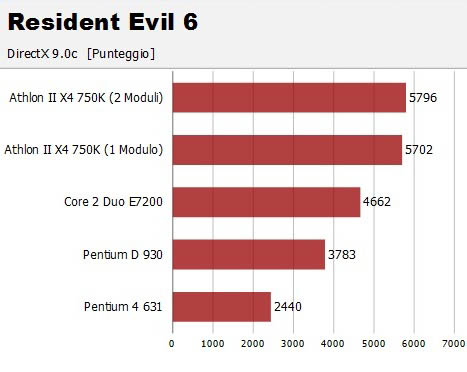


| CPU/Videogiochi | Pentium 4 631 | Pentium D 930 | Core 2 Duo E7200 | Athlon X4 750K (1M/2C) | Athlon X4 750K (2M/4C) |
| Devil May Cry 4 | - | +38% | +74,5% | +170% | +213% |
| Street Fighter IV | - | +49% | +73% | +149% | +264% |
| Resident Evil 6 | - | +55% | +91% | +134% | +137% |
I tre giochi commercializzati da Capcom, come accennato precedentemente, sono stati creati con Engine grafici sviluppati sul concetto base che più core ci sono meglio è. Incredibile, a tal proposito, il guadagno prestazionale che ha avuto l'engine di Street Fighter IV, creato ad-hoc per accontentare i fanatici dei picchiaduro, nel passaggio da 2 a 4 core. Giocando ad alti livelli, un engine grafico scattante e privo di rallentamenti è essenziale in un picchiaduro, come spiega Yoshinori Ono in questa intervista a PC Games Hardware: “We have developed everything including the graphics engine from scratch for SFIV. The reason being the fact it is important to be able to carry out trial & error and calibrate elements such as the graphics or the game system rapidly and internally by ourselves. We have spent a great deal of time on shaders and animation development”. Non a caso per sviluppare SFIV è stata scelta come base la versione PC (Windows). In un secondo momento è stato convertito per console.
Sempre nella stessa intervista, alla domanda “Can you give some detail about the thread structure? What different tasks can be or are split up into different threads and what is the expected performance gain resulting from two respectively four or even more (8) cores?”, Ono risponde: “I don't think we've done anything spectacularly different to other leading titles here but fundamental tasks such as rendering, audio and file I/O can be processed on separate threads. Also, the objects placed on the stages utilises ‘job system' and can be updated over several threads in a scalable manner. We have also tuned SFIV so that CPU resources do not change depending on the combinations of characters/stages as well as the game experience being constant, unaffected by CPU and GPU specs. Because of this, increasing the number of cores to run SFIV will certainly increase the performance but won't bring a great deal of other benefits”. Questo permette a chi possiede CPU con più core di avvantaggiarsi di questi per avere un effetto grafico migliore senza dover rinunciare ai dettagli.
Il MT Framework, utilizzato da DMC4 e RE6, invece stenta un po' ad essere sfruttato pienamente quando in gioco ci sono quattro core. Il vantaggio prestazionale si fa minore, segno che l'engine, datato 2004 e pensato principalmente per le console, comincia a sentire il peso degli anni. Nonostante ciò resta comunque apprezzabile il miglioramento di performance passando da una CPU ad un core ad una a due core.
I titoli Capcom, in conclusione, dimostrano come si debba programmare un videogioco MultiThreaded, così da conciliare sia un'ottima giocabilità sia un'ottima esperienza visiva.
